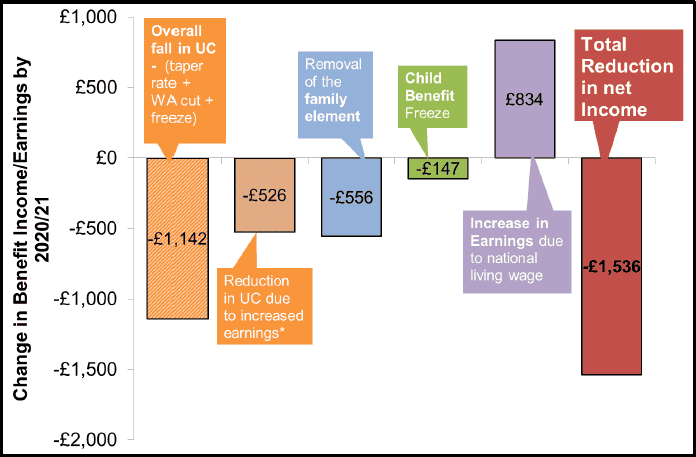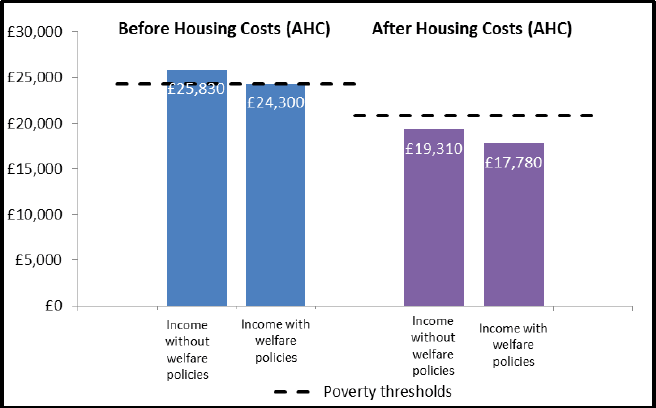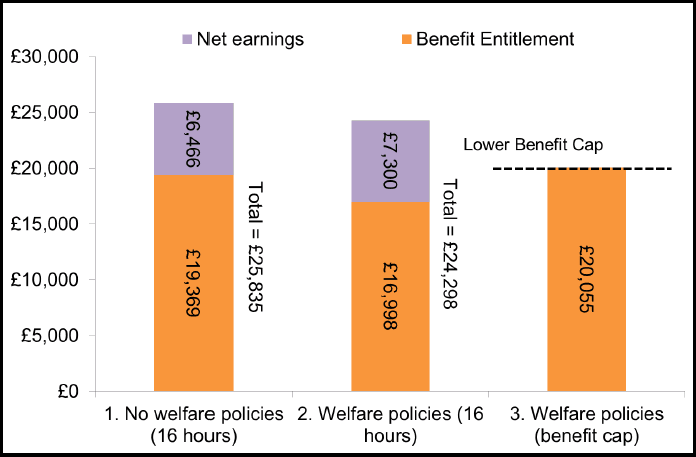UK welfare policy: impact on families with children
Report focusing on the financial impacts of UK welfare policy on families with children.
This document is part of 2 collections
7. Case study 2 – In work couple with 2 children (Mr and Mrs G)
Case study 2
Mr and Mrs G live with their 2 children (a boy aged 12 and a girl aged 9) in a 3 bedroom house. Their rent is £125 per week.
Mr and Mrs G have started a new claim to Universal Credit in 2020, after Mr G became unemployed. Mrs G continues to work part-time (16 hours) and receives Child Benefit for her two children. As a result of welfare policies, the family is not entitled to the higher child element for the first child (the equivalent of the family element).
Total Net Income (2020/21) without policy changes – £25,830
Total Net Income (2020/21) with all policy changes - £24,300
- 6% lower
- £1,540 less in Net Income per year
7.1 The Impact of Welfare policy on Mr and Mrs G
There were 87,000 in work couple families with children in Scotland who claimed Tax Credits in 2015/16, with approximately 36,000 [24] of these families having two children. As Universal Credit rolls out, these families will transition on to the new benefit.
As a result of welfare policy changes introduced since 2015/16, Mr and Mrs G and their family would be worse off by around £30 per week or around £1,540 per year by 2020/21. This represents almost a 6% reduction in what Mr and Mrs G and their family could have been entitled to in 2020/21 had these policies not been enacted.
Unlike in case study 1, the fact that Mrs G is in-work means that analysis of how worse off the family are due to welfare policies has to take account of the impact on earnings as well as benefits (see section 2).
Figure 6 shows that, due to the more generous level of the National Living Wage, Mrs G could earn around £830 more in 2020/21. However, this increase in outweighed by the fall in benefit entitlement.
Taking into account the increase in the taper rate (which would have marginally increased the UC award) the cut to UC work allowances and the freeze of UC standard and child elements means that it is estimated that the family's UC entitlement will fall by over £1,140 per year. UC entitlement falls a further £526 due to the fact that Mrs G's earnings increase over both scenarios, which reduces the amount of UC award [25] . Further losses of benefit come from the removal of the family element (£556 per year) and the freeze to Child Benefit (£150 per year).
Figure 6 - The change in benefit entitlement, earnings and net income for Mr and Mrs G due to welfare policies

Analysis of future poverty thresholds (see figure 7) suggests that the poverty threshold (before housing costs) for this household in 2020/21 would be around £24,300 per year. This means that, on a before housing cost basis, the implementation of welfare policies mean that Mr and Mrs G's income will just sit at the poverty line by 2020/21, compared to being £1,540 above the poverty line in the no welfare policy scenario.
Alternatively, on an after housing cost basis, Mr and Mrs G's net income places their family below the poverty line in both scenarios. However, the impact is still significant in terms of distance from the poverty threshold in both scenarios. Without welfare policy changes Mr and Mrs G's income is just 7% lower than the relevant poverty threshold, whereas with welfare policy changes Ms P's income is 15% lower.
Figure 7 – Net incomes (with and without welfare policies) against relevant poverty thresholds by 2020/21 (Case Study 2)

7.2 The Impact of the Benefit Cap on Mr and Mrs G
The Benefit Cap is not applied when the households earns no less than a given income threshold. Under Universal Credit this earnings threshold is calculated as 16 hours at the National Living Wage. Therefore, by 2020/21, it is estimated that the Benefit Cap earnings threshold will be £144.80 per week or £7,550 per year. In section 7.1, Mrs G earned exactly this amount and was therefore exempt from the Benefit Cap.
The Benefit Cap tends to disproportionately affect families with a lot of children and high housing costs. Since Mr and Mrs G only have two children and their housing costs are modest (below the LHA rates for their property type in their area), then even if Mrs G earned below the earnings threshold, this particularly family will not be affected significantly by the Benefit Cap.
Figure 8 - The impact on net income of Mrs G losing employment and the Benefit Cap applying to the household

Figure 8 shows the impact of the Benefit Cap on the net income of the family when Mr G does not work:
1. None of the 2015/16 welfare policies or changes to income tax thresholds or the National Living wage are implemented and Mrs G works 16 hours. In this case, by 2020/21 Ms P's net income is around £25,385.
2. All 2015/16 welfare policies and other changes are implemented and Mrs G works 16 hours. In this case, by 2020/21 her income is around £24,298
3. All 2015/16 welfare policies and other changes are implemented and Mrs G does not work. In this case, by 2020/21 her income is around £20,055. The household loses around £100 per year due to the Benefit Cap.
Contact
Email: Philip Duffy, Philip.Duffy@gov.scot
Phone: 0300 244 4000 – Central Enquiry Unit
The Scottish Government
St Andrew's House
Regent Road
Edinburgh
EH1 3DG
There is a problem
Thanks for your feedback